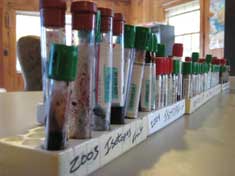Evaluating Spatial and Temporal Patterns of Mercury Exposure in Maine’s Inland Bald Eagle Population
Over the past decade, scientists have found that many North American wildlife species are exposed to harmful levels of mercury. Mercury is released into the environment directly, or into the atmosphere by both natural (wood burning, volcanoes) and human-caused processes (coal-fired power plants, waste incineration, gold mining, and others). Once deposited in the environment, mercury accumulates in organisms, often placing top predators like Bald Eagles at an increased risk.
What We Studied

Mercury has been linked to a wide variety of negative sublethal effects on birds, and it may limit some populations. Due to wind deposition patterns, wildlife in Northeastern North America are often at highest risk for the toxic effects of mercury. As a result, efforts to evaluate the potential for adverse effects of mercury on wildlife, and to evaluate temporal and geographic mercury trends, are highly warranted.
Sampling Bald Eagle tissues (i.e., blood, feather, and eggs) is an optimal way to identify contaminant “hotspots” that place fish-eaters at risk, and to monitor changes in mercury availability to wildlife over time. Several studies documented that Bald Eagles in Maine were exposed to some of the highest levels of mercury in the country (Welch 1994; conducted in 1991-1992).
Since those studies, Maine’s Bald Eagle population has continued to expand, providing new opportunities to evaluate mercury exposure in Bald Eagles from regions of Maine that were previously unavailable for sampling. With support from the Maine Department of Inland Fisheries and Wildlife, the Maine Department of Environmental Protection, FPL Energy Maine Hydro, and the U.S. Fish and Wildlife Service, we initiated a study to evaluate mercury exposure in Maine’s inland Bald Eagle population. Building upon previous efforts we wished to: (1) evaluate the current mercury exposure in Bald Eagles in lake and river habitats, (2) compare mercury exposure among major Maine watersheds, (3) determine if mercury may be slowing the recovery of Maine’s Bald Eagle population by affecting productivity, and (4) evaluate if mercury availability to Bald Eagles has changed since previous measures.
What We Found
Inland Bald Eagle nestlings in Maine have highly elevated mercury levels compared to the majority of other North American populations sampled. Bald Eagle nestlings sampled at lakes had significantly higher mercury exposure compared to those sampled in river habitats. Blood mercury levels sampled from eagles on Maine lakes, often in remote areas, were similar to populations associated with significant point-source pollution origins (e.g., mercury mines, dredging).
Mercury exposure in Maine Bald Eagles varied by major watershed, with the St. Croix River watershed containing the highest levels, and the (inland) Midcoast Maine watershed containing the lowest levels. Eaglet mercury exposure data were often consistent with findings in other biota (i.e., Common Loons, fish) used in other studies to delineate biological mercury hotspots where mercury is of significant concern.
Temporal comparisons between 1991-1992 and 2004-2006 periods do not suggest notable declines in the availability of mercury to Bald Eagles in Maine. This finding is consistent with previous indications that mercury can be relatively persistent in the environment. Maine’s eagle population is one of the few in the continental U.S. that has showed little evidence of declining mercury levels.
Preliminary comparisons between mercury and eagle productivity suggested that mercury may be slowing the recovery of Maine’s Bald Eagle population, and is being further in investigated with improved sample sizes. Adverse effect thresholds remain unknown for this species, but Bald Eagle pairs nesting at lakes with elevated mercury exposure, are at the highest risk for potential health effects.
Significance to Policy
Efforts to document contaminant exposure are prerequisite steps to informing the general public, environmental agencies, and decision makers about environmental concerns that have potential impacts on wildlife, human, and ecosystem health. This research helped demonstrate a need to evaluate mercury exposure in other wildlife throughout Maine, as well as in other regions where contamination may be of concern.
Relevant Reports and Publications
- DeSorbo, C. R. and D. C. Evers. 2005. Evaluating exposure of Maine’s Bald Eagle population to Mercury: assessing impacts on productivity and spatial exposure patterns. Report BRI 2005-08. Biodiversity Research Institute, Gorham, ME. 27 pp.
- DeSorbo, C. R. and D. C. Evers. 2006. Evaluating exposure of Maine’s Bald Eagle population to Mercury: assessing impacts on productivity and spatial exposure patterns. Report BRI 2006-02. Biodiversity Research Institute, Gorham, ME. 31 pp.
- DeSorbo, C. R. and D. C. Evers. 2007. Evaluating exposure of Maine’s Bald Eagle population to Mercury: assessing impacts on productivity and spatial exposure patterns. Report BRI 2007-02. Biodiversity Research Institute, Gorham, ME. 36 pp.
- DeSorbo, C.R., C.S. Todd, S.E. Mierzykowski, D.C. Evers, and W.Hanson. 2009. Assessment of mercury in Maine’s interior bald eagle population. USFWS. Spec. Proj. Rep. FY07-MEFO-3-EC. Maine Field Office. Old Town, ME. 42 pp. (peer reviewed)
- DeSorbo, C.R., N.M. Burgess, C.S. Todd, D.C. Evers, R.A. Bodaly, B.H. Massey, S.E. Mierzykowski, C.P. Persico, R.B. Gray, W.E. Hanson, D.E. Meattey, and K.J. Regan. (2018). Mercury concentrations in bald eagles across an impacted watershed in Maine, USA. Science of the Total Environment, 627, 1515-1527.


